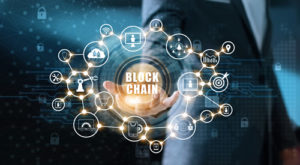A new report from the American Council on Education (ACE), funded by the U.S. Department of Education, examines blockchain’s potential in bridging a troubling and expanding gap between higher education and the labor market.
Blockchain–a technology that is a “shared, distributed ledger technology (DLT) that uses an agreed-upon and encrypted process to ensure that information on the ledger is tamper-proof, and that the data on the blockchain can be trusted even without centralized, third-party validation”– consists of three layers, as outlined by authors Kerri Lemoie and Louis Soares.
• Applications: This layer is how end users interact with DLT. As such, it might take the form of digital wallets, mobile interfaces, analytics tools, and the like.
• Protocol and network: This layer encompasses the software and processes that govern a distributed ledger, such as consensus mechanisms and issuance of tokens.
• Infrastructure: This layer encompasses the computers, servers, and systems that make up the peer-to-peer network running the distributed ledger (Nelson 2018).
Related content: Blockchain can transform higher ed with credentials
The COVID-19 pandemic has shed light on the gap between educational institutions and changing labor market demands–a communications gap resulting from a disconnect between how higher ed and the labor market each “talk about, measure, and signal individuals’ skills,” writes Ted Mitchell, ACE president, in the report’s foreword.
Even before the pandemic rocked the economy, underemployment and skills gaps were clear. In December, 4 in 10 recent college graduates were underemployed, with black and female graduates about 10 percentage points more likely to be underemployed than white and male peers. In the wake of unemployment concerns, “addressing issues of interoperability between education and employment is more important than ever.”
A move to recovery should allow employers to experiment with new technologies related to credentialing and hiring.
Blockchain is particularly well-suited to these goals, because it can establish stronger links between education and work, including helping workers better demonstrate their skills.
So, why blockchain?
Because our economy and global workforce are rapidly changing, individual workers’ ability to document, verify, and share data about their skills and knowledge could be a critical part of a system that enables personal career paths, along with economic competitiveness and social mobility.
Traditionally, employers and those evaluating an individual’s qualifications or suitability use resumes, CVs, high school diplomas, college transcripts, college degrees, licenses or certifications, and digital badges. This requires a lot of cross-communication and independent verification. As the number of credentials to verify learning and skills grows, it’s important for individuals to have control over their own credentials and to have the ability to document, verify, and share that knowledge and those abilities in real-time–something blockchain can offer in a tamper-proof format.
The authors note that research found 71 active efforts, mostly in proof of concept or pilot states, around blockchain and using DLT in education.
Challenges to using blockchain in education
Implementing DLT is still a work in progress in most cases.
Underuse of digital credentials: Digital credentials are being registered on blockchains, but they aren’t being claimed or used often, according to the report. It could be that those in evaluating positions don’t fully trust or understand digital credentials enough yet.
Data ownership and control: This is a murky issue, and control of data in learner records doesn’t necessarily indicate ownership. In some cases, learners are issued a Verifiable Credential using a public key–but if they lose their key, they also lose control of the data.
The digital divide: Not everyone has reliable internet access, or even internet access at all. The same is true of devices. DLTs can improve social equity, but everyone has to have access to the internet and devices.
Implementation costs: Investing in new technologies is often cost-prohibitive for institutions, and when they do replace existing processes, it takes time and manpower.
- First-generation students are more likely to seriously consider leaving college - April 17, 2024
- How higher ed can meet workforce needs - April 15, 2024
- Higher ed leaders believe continuing education units are undervalued - April 10, 2024

